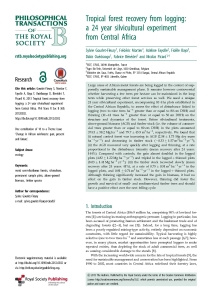Gourley-Fleury S., Mortier F., Fayolle A., Baya F., Ouédraogo D., Bénédet F., Picard N.
Large areas of African moist forests are being logged in the context of supposedly sustainable management plans. It remains however controversial whether harvesting a few trees per hectare can be maintained in the long term while preserving other forest services as well. We used a unique 24 year silvicultural experiment, encompassing 10 4 ha plots established in the Central African Republic, to assess the effect of disturbance linked to logging (two to nine trees ha−1 greater than or equal to 80 cm DBH) and thinning (11–41 trees ha−1 greater than or equal to 50 cm DBH) on the structure and dynamics of the forest. Before silvicultural treatments, above-ground biomass (AGB) and timber stock (i.e. the volume of commercial trees greater than or equal to 80 cm DBH) in the plots amounted 374.5 ± 58.2 Mg ha−1 and 79.7 ± 45.9 m3 ha−1, respectively. We found that (i) natural control forest was increasing in AGB (2.58 ± 1.73 Mg dry mass ha−1 yr−1) and decreasing in timber stock (−0.33 ± 1.57 m3 ha−1 yr−1); (ii) the AGB recovered very quickly after logging and thinning, at a rate proportional to the disturbance intensity (mean recovery after 24 years: 144%). Compared with controls, the gain almost doubled in the logged plots (4.82 ± 1.22 Mg ha−1 yr−1) and tripled in the logged + thinned plots (8.03 ± 1.41 Mg ha−1 yr−1); (iii) the timber stock recovered slowly (mean recovery after 24 years: 41%), at a rate of 0.75 ± 0.51 m3 ha−1 yr−1 in the logged plots, and 0.81 ± 0.74 m3 ha−1 yr−1 in the logged + thinned plots. Although thinning significantly increased the gain in biomass, it had no effect on the gain in timber stock. However, thinning did foster the growth and survival of small- and medium-sized timber trees and should have a positive effect over the next felling cycle.
Consultez la notice complète de l’article sur ORBi

